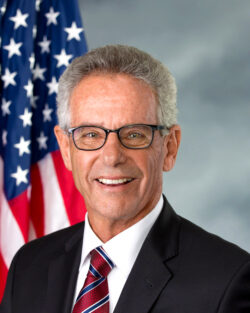
Positioning Ports to Counter Climate Change
By Congressman Alan, Lowenthal (CA-47)
Once again, ports are rising to the top of the Congressional Agenda. The Infrastructure Investment and Jobs Act invested more than $17 billion in port infrastructure and waterways. The Ocean Shipping Reform Act empowered the Federal Maritime Commission with the first update to the Shipping Act since 1998. At the same time, the Inflation Reduction Act includes $3 billion for port electrification and efficiency increases, alongside some of the most historic clean energy and carbon reduction investments in our history.
These are exciting developments, but as so often happens, Congress is also driven by the need to respond to overlapping, historic and unanticipated shocks to global markets and supply chains.
Ports have met the challenge of COVID-19, and the now-familiar series of economic shocks it triggered.
The unprovoked, illegal and completely unjustified Russian attack on Ukraine, and the heroic global response to Russian crimes further disrupted global markets.
At the same time, we must remain mindful of the ongoing threat posed by climate change. The evidence is extremely clear: The environmental, political, economic and social fallout that unchecked climate change will trigger could dwarf the crises of the past years.
Congress has taken major steps to address these measures through the Inflation Reduction Act, which promises long term clean energy investments, the largest climate investments in history, critical resources for ports, alongside, for good measure, anti-inflationary deficit reduction, bold reforms to ensure lower drug prices for seniors, and extension of Affordable Care Act subsidies.
The evidence is extremely clear: The environmental, political, economic and social fallout that unchecked climate change will trigger could dwarf the crises of the past years.
I am encouraged to see the American Association of Port Authorities (AAPA) stepping up to offer solutions to these crises through the Port Opportunities with Energy, Resilience, and Sustainability (POWERS) Program, which includes bold measures to reduce carbon emissions, promote alternative, low-carbon fuel infrastructure that will prove critical to the future health of the maritime industry, slash port emissions and strengthen resilience.
I recently introduced the Clean Shipping Act of 2022, the first zero-carbon standard for the maritime sector. This bill compliments the European Commission’s Fit for 55 package of legislative proposals to the greenhouse gas intensity of maritime operations.
This bill lays out the first path to a zero-carbon future for shipping, in compliance with our commitments under the Paris Climate Accords. The bill relies on the deployment of low-carbon fuels in the coming years. I am therefore extremely glad to see the AAPA POWERS program taking the necessary bold steps to support the development and deployment of next generation fuel infrastructure.
There are more critical components of the POWERS program I am eager to support here in Congress.
Shore power and electrification are imperative. Nearly 40% of Americans live within three miles of a port. It is crucial that we do everything possible to reduce the environmental and public health impacts of goods movement, and the POWERS program is an important step toward that goal.
Wind energy has long been a major priority for me, and I strongly support the development of direly needed support infrastructure as quickly as possible, yet another priority for the POWERS program.
This is an exciting time. Together, we can build on the success of the Infrastructure Investment and Jobs Act and the Inflation Reduction Act to bolster the long-term security and efficiency of our supply chains, while bolstering American jobs. We are strategically and wisely investing to put the future first.
Policymakers in Congress and the Administration understand the vital position of our nation’s seaports more than ever. As we work to continue to bring down costs for American consumers and to ensure the robust flow of essential goods, it is important that we continue to use our voices to prepare for future shocks to the supply chain, and to continue to increase our resilience.
I am proud to partner with AAPA as we work to accomplish these critical objectives.
Editor’s Note: AAPA is proud to feature the voices of a wide variety of thought leaders who care deeply about ports and supply chain resilience, funding, and success. This and forthcoming articles like it solely express the sentiments of the writer and may not reflect the beliefs of the American Association of Port Authorities (AAPA) and its stakeholders or members.
